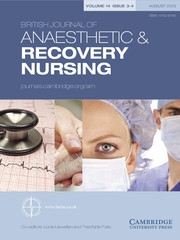No CrossRef data available.
Article contents
Post Anaesthetic Shaking
Published online by Cambridge University Press: 25 February 2009
Abstract
Bastien (1950), cited by Horn et al (1998b) first described post anaesthetic shaking over fifty years ago. Although the existence of this phenomenon is well documented, definition, cause and the benefits of individual treatments remain open for debate (Fotheringham 1998). However the mechanism for Post Anaesthetic Shaking (PAS) remains unclear (Sessler and Sessler 1998b), although the literature does suggest hypothermia is a factor, as too might be pain and stress. There are many variables effecting whether a patient will develop PAS. As much controversy remains regarding this condition the rationale for undertaking this paper is to improve care by broadening knowledge and thus allowing rapid and effective treatment to reduce the discomfort and distress experienced by the patient. This article is presented as a critical incident. Implications, for practice arising from this work suggest that more frequent monitoring and early intervention would enhance the available treatments. Further to this it appears that warming patients preoperatively, particularly those groups known to be at risk would reduce the incidence of hypothermia and consequently post anaesthetic shaking. Recommendations for future research would be further investigation in to the suggestion that body temperature need only vary by 0.2°C to affect a bodily response (such as shivering).
- Type
- Research Article
- Information
- Copyright
- Copyright © British Association of Anaesthetic and Recovery Nursing 2002


